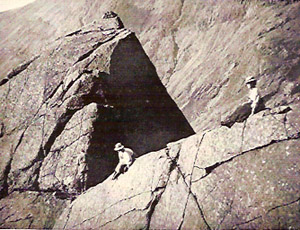
|
Origins of Bouldering |

|
Origins of Bouldering |
Early
Scottish Bouldering
|
| R. W. Clark
and E. C. Pyatt,
in Mountaineering
in Britain (1957), remark that in the period
prior to the establishment of the Scottish Mountaineering Club
(1889) , ".
. . almost all that had been done . . . was directly in the genuine
alpine tradition."
Later, the Club encouraged rock climbing for its own sake,
although it focused primarily on winter climbing. However, it appears
that bouldering
- although the word itself might not have been used - had
been
appreciated as a training method some years prior to the formal
creation of the Scottish Mountaineering Club. In Volume 4,
Number 1 (January 1896), of the Journal of the Club, T. Fraser S. Campbell
contributed an entertaining article entitled, "On
Boulders", which describes a pleasant game similar to the
one played today. Fraser alludes to his participation in these activities as being "many years ago", and, judging from his recollection of a climb described in the same Journal from his more youthful days in 1882, it seems probable that bouldering was practised during the mid 1880s, if not before. Certainly, after the formation of the Club, there was some interest in pure gymnastics on small rocks, as implied by a later comment in the journal: W. W. Naismith wrote in Volume 4 (1896) of a particular climb: "It is conceivable that a line might be chosen up those rocks, any part of which could be climbed if it were, say, on a 'boulder' . . ." |
| Excerpts from "On
Boulders" by T. Fraser S. Campbell Scottish Mountaineering Club Journal, Vol. 4, No. 1 (Jan 1896) |
||
"Many years ago there existed in Edinburgh a little coterie of enthusiasts, who were wont to devote most of their odd holidays to the exploration of the mountain systems of their native country. This was in prehistoric times, before the conception of the Scottish Mountaineering club had come to fruition. . . . "Upon some such occasion as this was the "Boulder Society" formed. This was the inspiration of the moment, and Stott [J. G. Stott, first editor of the Journal, died 1919] joined it with enthusiasm and offered his services as secretary, which the other half gratefully accepted. Stott's secretarial duties consisted for the most part of lying on his back in the shade with a pipe in his mouth, while the writer created 'lines of cleavage' in his nether garments, and generally defied the laws of anatomy by making improbable ascents of some Arran boulders." . . . "Now it is not my contention that one can practice the art of climbing complete - on a boulder; but I know many who have spent most pleasant hours in the pursuit of this branch of our favorite sport, which affords to the ambitious climber at least as good practice as falls to the golfer who 'putts' a ball along his drawing room carpet . . ." . . . " . . . the exercise of boulder-climbing is almost purely athletic, but the training to nerve and muscle may stand the climber in good stead . . . moreover it is comparatively free of danger." . . . "On the side of Loch Eck there is a huge rock cleft in two, the ascent of which, after several ineffectual attempts, was at last achieved by Lester [W. R. Lester] . . . In Glen Inveruglas there is a similar though smaller rock . . . an excellent climber . . . was much chagrined at his inability to . . . reach the top, from which two of his companions mocked his unavailing efforts." . . . "The accompaning illustrations, taken from photographs, are views of three[two] of the principal of the Arran boulders . . . In the picture to the left [Clach Mhor] is our worthy editor, grappling successfully with the mysteries of the 'friction grip' . . . [meanwhile] the Honorary Treasurer [is] engaged in a futile endeavor to establish frictional relations between his waistcoat buttons and a smooth rock surface." [balance climbing had yet to be introduced by Eckenstein on his eponymous boulder in Wales]
"It is not my intention to compare the ascent of these boulders to that of the Wastdale pillars, the gymnasium of English climbers . . . But sufficient amusement may be obtained on them to while away an idle afternoon . . ." |